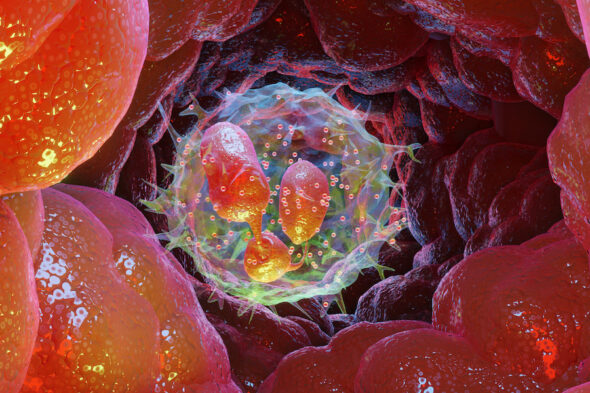How a blood vessel’s ‘zipper’ activates infection fighters
Two new papers from University of Illinois Chicago scientists examined the proteins that form the protective border inside blood vessels, finding that they play a key role in fighting disease and inflammation.
A thin layer of endothelial cells lines all blood vessels and forms an essential barrier that prevents unwanted leakage of blood and other circulating factors into organs and tissue. Preserving this barrier is an important protein called vascular endothelial cadherin, or VE-cadherin, which locks together like a zipper between the endothelial cells of blood vessel wall and leaves small junctions that selectively allow passage from blood and water to tissue.
Two new papers from the UIC Center of Lung and Vascular Biology and the Department of Pharmacology and Regenerative Medicine reveal how VE-cadherin is remodeled and how it interacts with the immune system. The findings may be important for understanding diseases ranging from COVID-19 to cancer and could offer new drug targets that boost the immune system or prevent damage from inflammation and infection.
The articles were led by Asrar Malik, Schweppe Family Distinguished Professor and the center’s director in the College of Medicine.

The first paper, published in Immunity, examined how the junctions formed by VE-cadherin help activate certain immune cells to fight off bacteria and fungi. During an infection, white blood cells called neutrophils are recruited into tissue by migrating through these extremely small passageways — one-thousandth the diameter of a hair — from blood into tissue, where they attack and kill microbial invaders.
The researchers, including the study’s first author and faculty-track instructor Amitabha Mukhopadhyay, discovered that the process of squeezing through these narrow junctions physically triggers a tension mechanosensor, called Piezo1, which prepares the neutrophils for the battle.
“We showed that these distortion forces were required to alter the phenotype of the neutrophil, so they become better killer cells,” Malik said.
This mechanism helps ensure that the immune cells are fully activated only at the site of the infection, instead of causing collateral damage to healthy tissue. But under conditions such as inflammation, where the connection between VE-cadherins is loose and the junctions widen, these neutrophils may not receive enough of a “squeeze” to activate, thereby reducing their antimicrobial activity.
In mouse models, the researchers recovered that function using genetic methods to tighten the passageways. Drugs that directly activate the Piezo receptors — which were the subject of the 2021 Nobel Prize in Physiology or Medicine — also could be effective therapies for activating neutrophils and boosting the body’s infection response, Malik said.
The second paper, published in Nature Communications and co-led by Chinnaswamy Tiruppathi, professor of pharmacology, reported the process by which VE-cadherin proteins are tagged for disposal and replaced by new versions. This regular renovation is critical for maintaining the integrity of the blood vessel wall and preventing leakage; its failure could lead to conditions such as atherosclerosis, where blood vessels stiffen and narrow, and other inflammatory diseases.

“The endothelial cells are not joined together like super glue — there’s always a turnover of cells,” Malik said. “Like any engineering design, the system can fail if it’s not properly rejuvenated.”
But excessive removal of VE-cadherin can lead to the leaky blood vessels seen in most inflammatory conditions or acute respiratory stress syndrome, the severe and often fatal lung symptom seen in viral infections such as COVID-19. Knocking out a key gene in this degradation process protected a mouse model from pneumonia lung injury and vascular inflammation, suggesting that temporarily interrupting this process with a drug could help maintain blood vessel integrity and avoid critical damage in sick patients.
“One could use that concept to create a drug that would make the junctions more rigid and unbreakable,” Malik said. This strategy is the main thrust of a biotechnology company founded by Malik and his colleagues.
The Immunity paper was co-authored by Yoshikazu Tsukasaki, Wan Ching Chan, Jonathan P Le, Man Long Kwok, Jian Zhou, Viswanathan Natarajan, Nima Mostafazade, Mark Maienschein-Cline, Ian Papautsky, Chinnaswamy Tiruppathi, Zhangli Peng, Jalees Rehman, Balaji Ganesh and Yulia Komarova.
Additional co-authors on the Nature Communications paper included Dong-Mei Wang, Mohammad Owais Ansari, Shabana Bano, Yoshikazu Tsukasaki, Amitabha Mukhopadhyay and Jagdish C. Joshi.
